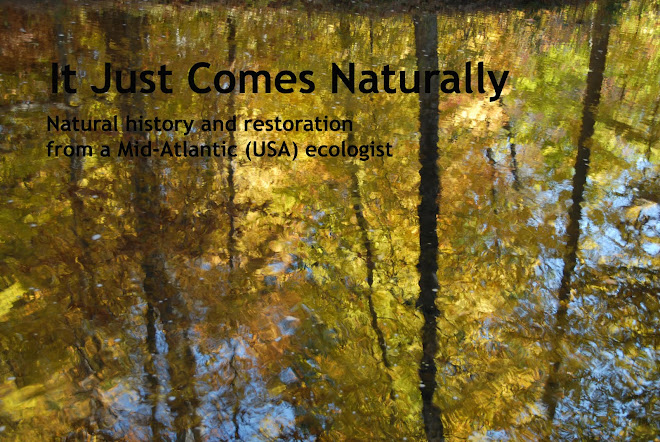The riparian area had been part of a landscaped estate through the 1960s when it featured non-native specimen trees and lots of naturalized spring bulbs in a lawn sloping down to the creek. But, with the passing of the estate into the hands of a church, the challenging riparian area was all but abandoned. Parts of it developed naturally into a nice stand of native swamp rose, but for the most part, it was overrun by non-native multiflora roses. When we acquired the floodplain and created a trail alongside the creek, we also began planting trees to close up the sunny, invasive-dominated meadow and to return forest to the floodplain and adjacent slopes.
The volunteers who showed up to help were members of three families plus two college students. One of the families brought their young children, who had a great time helping out and getting as muddy as possible. The group managed to plant 40 trees and surround them with deer-proof wire cages in less than two hours.
_____
 |
| Image by dpughphoto.com |
For the last few days, I've noticed a Pine Warbler coming to the feeder outside my kitchen window to eat suet. At first, not observing carefully, I casually wrote it off as an American Goldfinch that hadn't fully molted into its glorious breeding plumage. Then I realized that, if it hadn't molted by now - prime breeding season - it wasn't going to to molt and it must be some other species. On more careful observation, I realized it was a Pine Warbler. But, a Pine Warbler coming to a feeder? Unheard of! Nonetheless, there it was, and there was no doubt about its identity. Then, as I searched the Internet for an image of a Pine Warbler to accompany this post, what did I find but an image of the bird taken at - you guessed it - a suet feeder?!
_____
Saturday night's torrential rains that made tree planting so muddy on Sunday morning also flooded the old farm pond down the hill behind my house. The pond contained a small island commandeered for the last several years by the same pair of Canada geese. Last year, the geese's nest was inundated by heavy April rains, and it happened again this year. Certainly, we don't need any more Canada geese around, so I don't regret their loss for that reason. But, clearly the female was distraught. Last evening, I watched her just standing in the two inches of water above her former nest. Perhaps this personal disaster is for the better, though; the pond harbors several snapping turtles, and the geese usually fail to raise a brood to adulthood anyway. Is it better to lose a nest of eggs, or to watch your brood get smaller each day as a hungry turtle pulls your goslings, one by one, under water?
_____
Dark-eyed Juncos have forsaken my feeder for breeding grounds further north, but White-throated Sparrows are still here in force and stridently practicing their mating calls. They always stick around a little longer than the Juncos, but they, too, will be gone in a few days.






